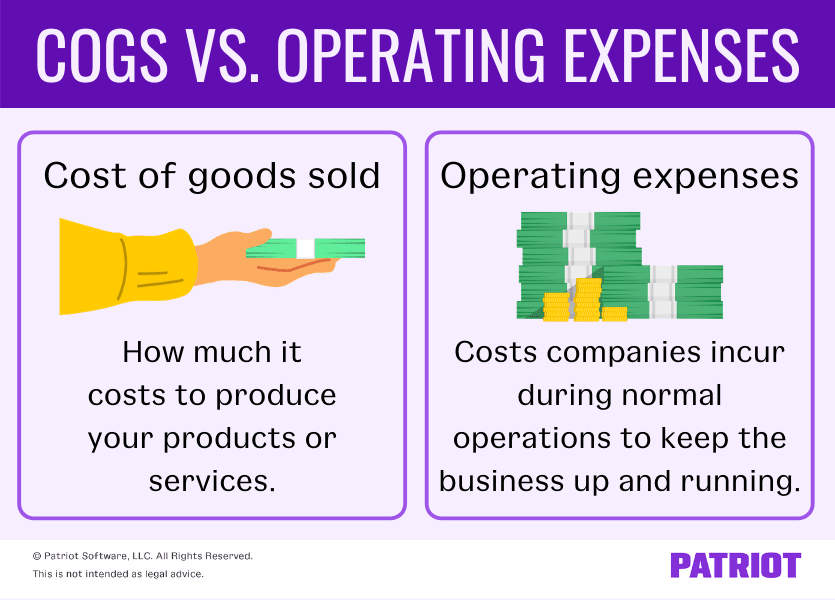Part of running a business is recording day-to-day operating costs in your books. These expenses fall into two categories: cost of goods sold (COGS) or operating expenses. But what’s the difference between the two? Read on to learn about cost of goods sold vs. operating expenses and how to tell the difference when doing your books.
Cost of goods sold vs. operating expenses
COGS and operating expenses are both costs you incur during your business’s daily operations. You must record them separately on your business’s income statement. Failing to accurately record them can throw off your financial statements and books.
To understand the difference between cost of goods sold and operating expenses, check out the overview and examples of both below.
Cost of goods sold
The cost of goods sold, also known as cost of sales or services, is how much it costs to produce your products or services. Your COGS includes the direct costs of producing your offerings, such as:
- Direct materials
- Direct labor
COGS does not include indirect expenses, like overhead costs. When calculating your cost of goods sold, do not factor in costs like utility, marketing, rent, and shipping expenses.
For example, the cost of goods sold for a cup of coffee accounts for things like the to-go cup, sleeve, coffee filter, water, coffee beans, etc. It does not include other costs, like electricity to run machinery.
To find the cost of goods sold on a product, add up the cost of raw materials and direct labor. Use the following formula to determine your total COGS during a period (e.g., month, quarter, year):
COGS = Beginning Inventory + Purchases During the Period – Ending Inventory
Your beginning inventory is the leftover inventory from the previous period. Add the cost of what you purchased during the period. Subtract the inventory you did not sell at the end of the period. And voila! You have your cost of goods sold.
Your COGS can help you set prices that give you a healthy profit margin. Not to mention, it can help you calculate your business’s overall profit.
Calculating COGS example
Say your business has a beginning inventory of $5,000, makes $1,500 in purchases during the period (quarter), and has an ending inventory of $500. Plug your totals into the COGS formula to find your cost of goods sold for the period.
COGS = $5,000 + $1,500 – $500
Your cost of goods sold for the quarter is $6,000.
Operating expenses
Operating expenses (OPEX), also known as operating expenditures or operational expenses, are costs companies incur during normal operations to keep the business up and running. An operating expense is an ongoing cost of running a business. Operating expenses might also be referred to as SG&A (sales, general, and administrative expenses).
Essentially, an operational expense is the opposite of COGS. It includes all of the expenses that don’t fall under the cost of goods sold category and aren’t directly tied to the production of the good or service. Here are some examples of operating expenses:
- Rent
- Equipment
- Marketing
- Salaries and wages (other than direct labor)
- Insurance
- Office supplies
Again, operating expenses do not include cost of goods sold (e.g., direct materials and labor). To calculate your total operating expenses, add all of your operating costs up.
Like COGS, operating expenses can show you how profitable your business is. An increase in operating expenses means less profit for your company.
You might try to reduce operating expenses to give profits a boost. However, you have to be careful to ensure you’re not sacrificing quality and your business’s integrity. Businesses can reduce operating expenses by automating tasks, cancelling unused services and subscriptions, and shopping around before making a purchase. Take a look at your operating budget to see where you can cut costs.
The IRS also allows businesses to deduct operating expenses if the business is for-profit. To learn more about what business expenses you can deduct, check out the IRS’s website.
Operating expenses example
Say you own a bakery. Each month, you pay $800 in rent, $150 for insurance, $3,500 for payroll costs, $100 for marketing, $250 for utilities, and $50 for office supplies. To find your total operating expenses for the month, add up your expenses:
Operating Expenses = $800 + $150 + $3,500 + $100 +$250 + $50
Your total operating expenses for the period are $4,850.

Recording COGS and operating expenses in your books
Cost of sales and operating expenses are both types of expense accounts. You can find both operating expenses and COGS on your business income statement in separate sections. Your income statement is a financial report that shows your business’s profits and losses over a certain amount of time.
Here’s an example of what your income statement may look like with COGS and OPEX:
| Revenue | $10,000 |
| Cost of Goods Sold | $2,000 |
| Gross Profit | $8,000 |
| Expenses | |
| Marketing | $200 |
| Payroll Expense | $2,000 |
| Insurance | $200 |
| Office Supplies | $50 |
| Utilities | $250 |
| Rent | $800 |
| Total Expenses | $3,500 |
| Net Profit | $4,500 |
To find gross profit, subtract COGS from your total revenue. Then, subtract your total operating expenses from your gross profit to find net profit.
Are you tracking the numbers you need to compute your cost of goods sold and operating expenses? Patriot’s online accounting software makes it easy to record business income and expenses. Plus, we offer free, USA-based support. Get your free trial today!
This is not intended as legal advice; for more information, please click here.
